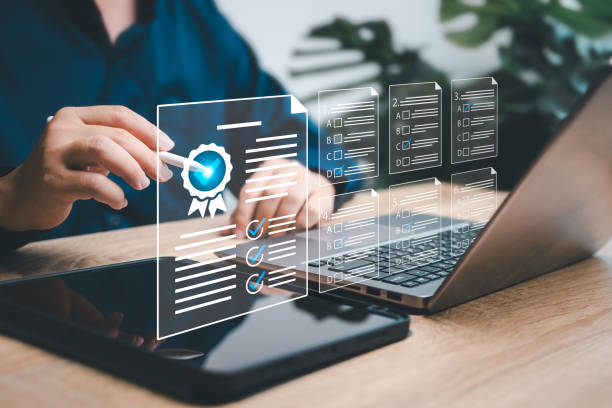Introduction to On-Page SEO: What Is It and Why Is It Important?

On-Page SEO, or #On-Page_SEO, is a set of actions and techniques applied within your website to improve its ranking in search engine results.
This includes optimizing various elements such as content, HTML code, and site structure.
The importance of #On-Page_SEO stems from the fact that search engines like Google, by precisely analyzing these factors, gauge the relevance and quality of a page in relation to the user’s search query.
A website with strong On-Page SEO can clearly introduce its content to search engines and increase its chances of being seen among millions of other pages.
This aspect of SEO helps you maintain complete control over how your pages are displayed and ranked, from appropriate keywords to site loading speed and user experience.
A deep understanding of the fundamentals of On-Page SEO and its correct application is the cornerstone of any successful digital marketing strategy and directly impacts your organic traffic and ultimately, your business growth.
Many websites, despite excellent content, never reach top positions due to weaknesses in On-Page SEO factors.
Therefore, this field is not just an option, but a necessity for visibility in today’s competitive world.
Did you know that 94% of users’ first impressions of a business are related to its website design? With professional corporate website design by **RasaWeb**, turn this first impression into an opportunity for growth.
✅ Attract more customers and increase sales
✅ Build credibility and trust in the audience’s eyes⚡ Get a free website design consultation!
Keywords: The Backbone of On-Page Content Optimization

Keywords are the core of any successful on-page optimization strategy.
Finding the right keywords means accurately understanding what users are looking for in search engines.
This process involves extensive research to identify phrases that are not only relevant to your content but also have a suitable search volume and reasonable competition.
In addition to main keywords, using LSI (Latent Semantic Indexing) keywords, or semantically related keywords, helps search engines understand your content more comprehensively.
For example, if your main keyword is “coffee”, LSI keywords could include “coffee beans”, “espresso coffee”, “cafe”, and “caffeine”.
This approach ensures that your content is rich and semantically complete.
Also, paying attention to Long-tail Keywords, which consist of three or more words, can attract much more targeted traffic to your site, as users with these phrases have a more specific intent and are often in the later stages of the sales funnel.
Naturally and intelligently integrating these keywords into the title, headings, body text, and meta descriptions is the key to success in On-Page SEO, and “keyword stuffing”, which disrupts user experience and is penalized by search engines, should be avoided.
Content Optimization for On-Page SEO and User Experience
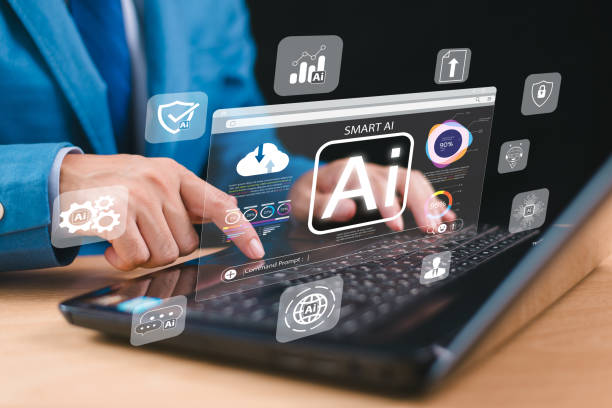
Content is king, but content optimized for On-Page SEO and User Experience (UX) wears the crown.
High-quality content, valuable to users and understandable by search engines, is of paramount importance.
This optimization includes ensuring text readability, correct use of heading structures (H1, H2, H3, etc.) for organizing information and improving scanability, as well as enriching content with relevant images, videos, and infographics.
The E-A-T principle (Expertise, Authoritativeness, Trustworthiness), introduced by Google, emphasizes the importance of expertise, authority, and trust in content.
To create expert and trustworthy content, it is necessary to provide accurate and documented information and cite reliable sources.
Also, paying attention to sentence structure, short paragraphs, and using lists can significantly increase readability.
Your content should answer user questions and meet their needs.
This approach not only improves your ranking in search results but also increases user dwell time on the site and reduces the bounce rate, which are important positive signals for search engines.
Below, the following table shows content types and their impact on SEO:
| Content Type | Main Goal | Impact on On-Page SEO |
|---|---|---|
| Educational Content (How-to Guides) | Provide step-by-step solutions | Attract targeted traffic, increase dwell time, answer long-tail questions |
| Question-based Content | Stimulate thought, create engagement | Opportunity for Featured Snippets, increase click-through rate, reduce bounce rate |
| Expert Content (Deep Dive Articles) | Provide in-depth analysis and accurate information | Build credibility and expertise (E-A-T), attract high-quality backlinks |
| News Articles | Inform about current events | Increase sudden traffic, visibility in Google News, continuous site updates |
| Guidance Content (Guides & Tutorials) | Provide a clear path for task completion | Address user information needs, build trust, improve ranking |
| Analytical Content | Review data and provide insights | Establish thought leadership, attract users interested in details |
Optimizing Title Tags and Meta Descriptions for On-Page SEO
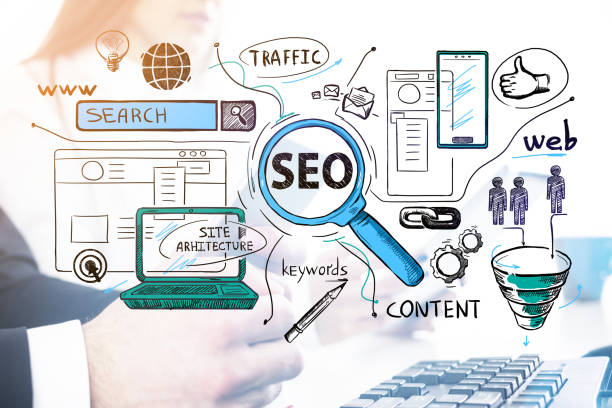
Title Tags and Meta Descriptions are two crucial elements in On-Page SEO that play a significant role in attracting clicks from search results (CTR).
The title tag is the title displayed in the browser’s top bar and also as the main title of your page in search results.
This tag should include the main keyword of the page and, at the same time, be attractive and compelling to encourage users to click.
The standard length for a title tag is usually between 50 and 60 characters to be fully displayed in Google’s results.
Meta descriptions are also short texts that appear below the page title in search results and provide a summary of the page’s content.
Although meta descriptions are not direct ranking factors, they play a very important role in encouraging users to click on your link.
A good meta description should include keywords, a Call-to-Action, and text that attracts users.
The ideal length for a meta description is around 150 to 160 characters.
Both of these elements should be carefully adjusted according to the page’s content to have the maximum impact on attracting the attention of users and search engines.
Continuous optimization of these tags and A/B testing them can significantly help improve the overall performance of your site’s On-Page SEO.
Does your current website build the trust that potential customers should have in your business? If not, it’s time to have a professional and impactful corporate website with RasaWeb.
✅ Fully custom design tailored to your brand identity
✅ Increase lead generation and your business’s credibility in the eyes of customers⚡ Contact us for a free consultation!
URL Structure and Internal Linking for Better On-Page SEO
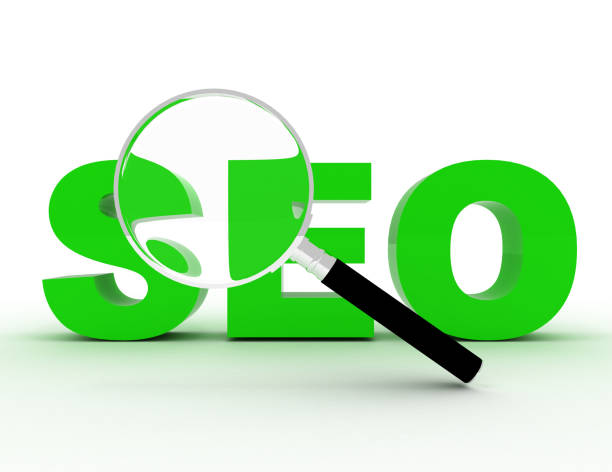
A proper URL structure not only helps users understand their path on your site but also assists search engines in comprehending your content’s structure and hierarchy.
Clean, short URLs containing main keywords are highly preferred in terms of On-Page SEO.
Avoid using unnecessary characters, meaningless numbers, and dynamic parameters that can be confusing.
For example, instead of “yoursite.com/?p=123” use “yoursite.com/category/article-title”.
Internal Linking is also one of the most powerful tools in On-Page SEO.
Internal links are links that connect different pages within your website to each other.
This not only helps users navigate your site easily and find related content but also assists search engines in discovering and indexing new pages and distributing “Page Authority” throughout the site.
Using descriptive and keyword-rich Anchor Text when internal linking is very important.
This provides search engines with more information about the destination page’s content.
A strong internal linking strategy can help improve the ranking of your key pages and significantly enhance user experience.
This process should be carried out continuously and purposefully and be an integral part of your On-Page SEO strategy.
The Role of Images and Videos in On-Page Site Optimization
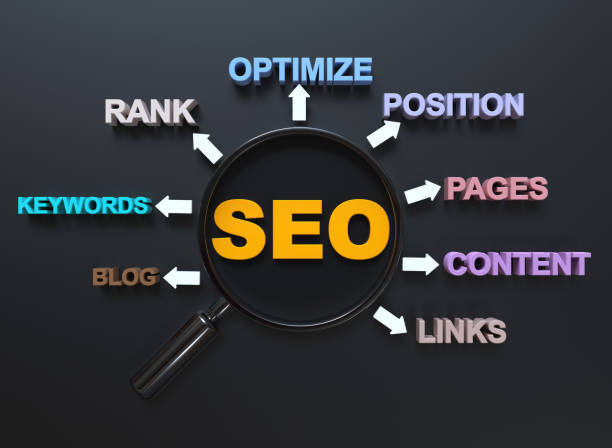
Visual content, including images and videos, plays a vital role in increasing the attractiveness of your content and improving on-page site optimization.
Using high-quality images and relevant videos not only enhances user experience but can also help your SEO ranking.
For images, optimization includes compressing file size for faster loading speed, using descriptive file names, and most importantly, filling in the Alt Text (alternative text).
Alt text helps search engines understand the image content and is also beneficial for users with visual impairments.
Alt Text should be descriptive and include relevant keywords.
Regarding videos, optimization includes creating video schema markup, generating transcripts and captions for the video, and using appropriate video file names and descriptions.
Embedding videos from platforms like YouTube onto your website can help with Video SEO, as YouTube is owned by Google, and its content is easily indexed by Google.
Engaging visual content not only keeps users on your site longer (which is a positive signal for Google) but can also lead to more social media shares and increased engagement.
Therefore, investing in the production and optimization of visual content is a crucial component of any comprehensive on-page site optimization strategy.
Site Speed and Mobile Responsiveness in On-Page SEO
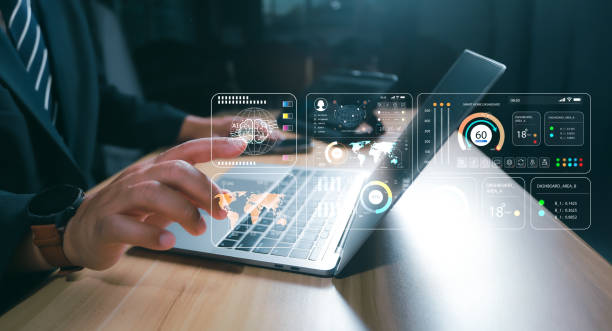
Site loading speed and mobile responsiveness are two critical factors in modern On-Page SEO that heavily impact user experience and ranking.
In today’s world, where users expect web pages to load instantly, even a few seconds of delay can mean losing visitors.
Google has explicitly stated that site speed is a ranking factor and evaluates website performance in this regard through Core Web Vitals metrics.
These metrics include LCP (Largest Contentful Paint) for main content loading speed, FID (First Input Delay) for interactivity, and CLS (Cumulative Layout Shift) for visual stability.
Optimizing images, caching, using a CDN (Content Delivery Network), and choosing suitable hosting are solutions for increasing site speed.
In addition to speed, Mobile Responsiveness is also of high importance.
Given that a significant portion of searches are conducted via mobile devices, Google has adopted a Mobile-First Indexing policy, meaning your site’s mobile version is used for initial indexing and ranking.
Ensuring that your website displays correctly on any screen size and provides a seamless user experience is crucial.
This includes responsive design, using readable fonts, and ensuring that buttons and links function correctly on touch devices.
Tools like Google PageSpeed Insights and Google Mobile-Friendly Test can help you evaluate and improve these factors.
The following table shows the main Core Web Vitals metrics:
| Metric | Description | Importance in On-Page SEO |
|---|---|---|
| Largest Contentful Paint (LCP) | The time it takes for the largest content element visible in the user’s viewport to render. | Indicates overall page loading speed, direct impact on initial user experience. Less than 2.5 seconds is ideal. |
| First Input Delay (FID) | The time from the user’s first interaction with the page (e.g., clicking a button) to when the browser is able to respond to that interaction. | Indicates site responsiveness. Smoother user experience leads to reduced bounce rate. Less than 100 milliseconds is ideal. |
| Cumulative Layout Shift (CLS) | Measures the visual stability of the page; the amount of unexpected layout shifts of page elements. | Prevents unpleasant user experiences like accidental clicks. The CLS score should be less than 0.1. |
Website Security (HTTPS) and Its Role in Content SEO

Website security is one of the factors that Google is increasingly emphasizing and has a direct impact on content SEO and overall site ranking.
Migrating from HTTP to HTTPS with the installation of an SSL certificate is no longer an option but a necessity.
HTTPS (Hypertext Transfer Protocol Secure) ensures that all information exchanged between the user’s browser and your website server is encrypted and secure.
This is especially critical for websites that collect sensitive information such as personal or banking details.
Google has officially announced that HTTPS is a ranking factor.
Sites that use HTTPS often have an advantage in search results over their HTTP counterparts.
In addition to directly impacting ranking, HTTPS also increases user trust.
When users see the “padlock” icon next to your website’s address, they feel more secure, and this can lead to increased engagement rates and reduced bounce rates.
An insecure website can lead to browser warnings that deter users from entering your site.
Therefore, ensuring that your website is fully secure and equipped with HTTPS is an essential step in improving your On-Page SEO and maintaining your online credibility.
Ignoring security can nullify all your efforts in other aspects of SEO.
Are you tired of your e-commerce website not generating as much revenue as it could? RasaWeb, specialized in designing professional e-commerce websites, solves this problem permanently!
✅ Increase sales rate and revenue
✅ High loading speed and exceptional user experience
⚡ Get a free e-commerce website design consultation
Advanced Tips and Practical Tools for On-Page SEO Factors

After covering the basics, it’s time to explore advanced tips and practical tools for On-Page SEO factors that can help you achieve a competitive edge.
One such tip is the use of Schema Markup or structured data.
Schema are codes that help search engines understand your page’s content in a more structured and semantic way.
This data can lead to the display of “Rich Snippets” in search results, such as star ratings for products, contact information, or event details, which increase click-through rates.
SEO tools play a vital role in analyzing, monitoring, and improving On-Page SEO.
Google Search Console is a free and essential tool that allows you to view your site’s performance in Google search results, identify crawl errors, and check the indexing status of pages.
Paid tools like SEMrush and Ahrefs offer broader capabilities, including keyword research, competitor analysis, backlink analysis, and site auditing, which are necessary for a comprehensive On-Page SEO strategy.
Additionally, using SEO plugins for platforms like WordPress (e.g., Yoast SEO or Rank Math) can simplify the optimization process.
By utilizing these tools and advanced techniques, you can continuously monitor and optimize your site’s On-Page SEO performance.
Monitoring and Analyzing On-Page SEO Performance

On-Page SEO efforts would be incomplete without continuous performance monitoring and analysis.
To ensure that implemented strategies are effective and yield positive results over time, it is necessary to regularly review and analyze data.
Google Analytics is a powerful and free tool that allows you to track website traffic, user behavior, bounce rate, dwell time, and other key metrics.
This data can provide valuable insights into which pages are performing well and which ones need improvement.
Furthermore, using Google Search Console is crucial for monitoring keyword rankings, identifying crawl issues, checking page indexing status, and viewing internal and external links.
This tool shows you how your site is seen by search engines and what problems might exist in the indexing and ranking process.
Regular monitoring of these tools helps you quickly identify and fix On-Page SEO issues.
Additionally, Rank Tracking Tools allow you to track your site’s position for specific keywords over time and observe the impact of SEO changes.
Accurate analysis of this data enables you to optimize your On-Page SEO strategies and ensure a sustainable growth path for your website.
This is an iterative process that requires continuous attention and adaptation to changing search engine algorithms.
Frequently Asked Questions
| Question | Answer |
|---|---|
| What is On-page SEO? | On-page SEO refers to a set of actions performed within your website to improve its ranking in search engine results. This includes optimizing content, site structure, and HTML code. |
| Why is On-page SEO important? | On-page SEO helps search engines understand your page’s content and determine if your content is relevant to searchers. It is the foundation of any successful SEO strategy. |
| What are the key elements of On-page SEO? | Page title (Title Tag), meta description, keyword usage, image optimization, heading structure (H1, H2, …), internal linking, and content quality are key elements. |
| How to optimize the page title (Title Tag)? | The page title should include the main keyword, be attractive and compelling for clicks, and be between 50 to 60 characters (or appropriate pixels) in length to be fully displayed in search results. |
| What role does Meta Description play in On-page SEO? | The meta description is a summary of the page’s content displayed below the title in search results. Although it doesn’t directly affect ranking, it helps SEO by increasing the click-through rate (CTR). |
| What is the importance of using heading structure (H1, H2, H3) in On-page SEO? | Headings structure the page content and make it easier to read. H1 is typically the main title of the page and should include the main keyword. H2 and H3 are used to organize sub-sections and help search engines understand the content hierarchy. |
| How to effectively use keywords in content? | Keywords should be used naturally and logically throughout the content, including the introduction, body, and conclusion. Avoid excessive keyword stuffing. |
| What steps are involved in optimizing images for On-page SEO? | This includes compressing images to reduce size, using descriptive file names, adding appropriate Alt Text, and optimizing the image title and description. Alt Text is crucial for accessibility and helping search engines understand image content. |
| What is Internal Linking and what are its benefits? | Internal linking means creating links from one page on your website to another page on the same website. This helps users navigate your site easily, distributes page authority across the site, and helps search engines better understand your site’s structure. |
| What is the importance of content quality in On-page SEO? | High-quality, accurate, comprehensive, and valuable content for users, is the cornerstone of On-page SEO. Search engines prefer content that meets user needs. Quality content leads to longer dwell time and lower bounce rate, which are positive SEO signals. |
And other services of RasaWeb Advertising Agency in the field of advertising
Smart Digital Branding: A fast and efficient solution for increasing sales with a focus on intelligent data analysis.
Smart Digital Branding: A combination of creativity and technology for digital branding through intelligent data analysis.
Intelligent Data Analysis: A professional solution for digital branding with a focus on intelligent data analysis.
Smart Brand Identity: An exclusive service for growth in sales based on attractive user interface design.
Intelligent Data Analysis: A professional solution for customer acquisition with a focus on attractive user interface design.
And over hundreds of other services in the field of internet advertising, advertising consultation, and organizational solutions.
Internet Advertising | Advertising Strategy | Advertorial
Sources
Iran Server – SEO BasicsRastad – What is SEO?Modirweb – SEO TrainingSEO Iran – SEO Articles
? To elevate your business in the digital world, RasaWeb Afarin Digital Marketing Agency, specializing in SEO, online advertising, and user-friendly website design, is with you to ensure a powerful and lasting presence.
📍 Tehran, Mirdamad Street, next to Bank Markazi, Kazeroun Jonoubi Alley, Ramin Alley No. 6

